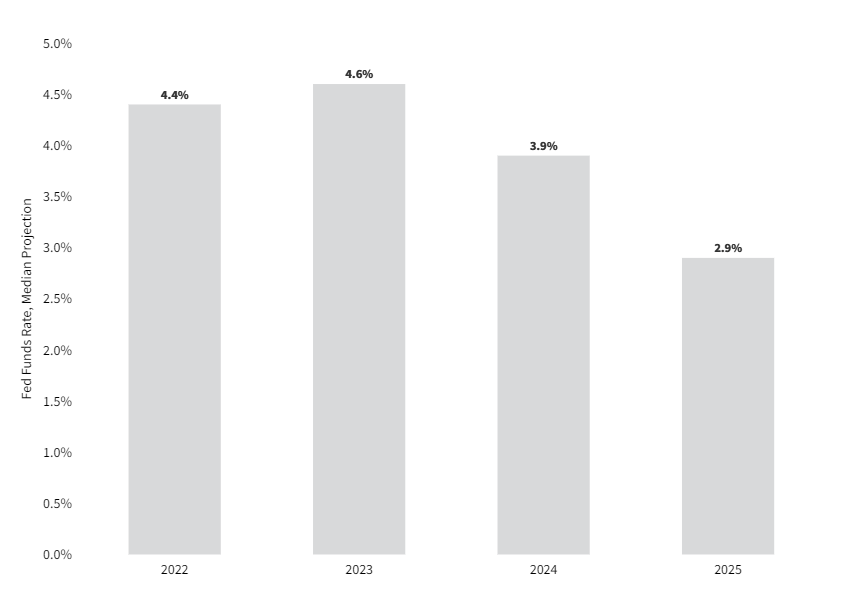As the Fed seeks to temper inflation, the commercial real estate industry buckles in for more challenges ahead
Quick takes:
- Fed hikes rates and turns more aggressive
- Recession risk increases
- Inflation likely to slow further over time
- Fiscal policy not likely to help very much
- CRE faces more challenging path ahead
Here we go.
The Fed’s actions and forecasts from last week potentially set in motion a further slowing in economic momentum in its efforts to slow inflation. The Fed has signaled that it believes inflation poses a significant risk of a relatively long, deep recession down the road, if inflation expectations become unmoored. To avoid that, the Fed is clearly willing to risk, by its own hand, a shorter, shallower recession in the short term. Market movements have begun to reflect this possibility with the equity markets pulling back into bear market territory and bond yields moving up.
An even more-aggressive Fed
The Fed predictably raised the target fed funds rate by 75 basis points (bps), bringing the target range to 300-325 bps and pushing past our (and most people’s) estimate of the neutral rate. That means it has almost certainly moved into territory where it will begin to restrict economic activity. But more importantly, the Fed substantially increased the forecast for the fed funds rate. For 2022, the Fed increased the forecast for the terminal rate by roughly 80 bps to 4.4% and for 2023, when it more explicitly expected rates to come down, by roughly 120 bps. The Fed does not now foresee the terminal rate starting to decline until 2024.

Raising recession risk
Such aggressive tightening clearly raises the recession risk for 2023. While GDP growth should still rebound over the balance of this year, by the middle of next year higher rates should restrain economic activity. Our model now forecasts GDP slowing near stall speed, with GDP contraction toward the middle of the year likely. Does that explicitly mean a recession? Not necessarily. GDP contracted in the first half of this year without producing a recession. Even the Fed’s own forecast foresees wider fallout from rate hikes. The Fed might not follow through on its own forecast if economic momentum slows more than it anticipates, but that remains to be seen.
“Our model now forecasts GDP slowing near stall speed, with GDP contraction toward the middle of the year likely. Does that explicitly mean a recession? Not necessarily.”
What about inflation?
Then what about inflation, the cause of all this trouble? We have likely already passed peak inflation. Energy prices are already declining with oil falling back to levels last seen in January and gasoline continuing to decline since peaking in June. Meanwhile, the global supply chain continues to slowly improve, even though it remains disrupted. Moving forward, we expect slow and inconsistent declines in inflation over the balance of the year and more meaningful deceleration after that as higher interest rates restrain demand more meaningfully and base effects make it mathematically more difficult to sustain high inflation.
“We have likely already passed peak inflation.”
What about fiscal policy?
Fiscal policy role will likely shift as monetary policy tightens. During the last two fiscal years, fiscal policy helped to support and stimulate the economy, likely playing a role not only in generational economic growth but also generational inflation. But that seems likely to change. While fiscal policy should still provide for much discretionary spending, the appetite for further stimulus packages seems muted. That should prove especially likely if the Republicans retake at least one house of Congress which seems likely at this point. This could create a divergence in policy between the U.S. and Europe which may provide additional fiscal support in the face of higher inflation and slowing growth. We do not foresee spending cuts like last business cycle. But the usual fiscal support that we might expect during a period of slowing growth or contraction might not occur. Yet, the lingering impact of previous fiscal support remains for now. Consumer balance sheets still hold more than $2 trillion that consumers will have at their disposal. Though how quickly that will dissipate remains an open question.
| What we are watching this week |
Personal income and spending for August both likely increased at a healthy pace. The personal consumption expenditures (PCE) index for August should show further gains, pushing inflation up. Both consumer confidence and sentiment for September both likely ticked up. New home sales should improve versus July but look relatively weak. Finally, we expect jobless claims to remain at low levels.
| What it means for CRE |
For now, the underlying economic drivers of commercial real estate (CRE) remain in place. But the path forward now looks more challenging. The Fed will have much to say about the path forward for the economy and consequently CRE. If (and we stress if) the Fed pushes too far, then CRE will also run into trouble because of its procyclical nature. But any disruption to the economy should prove relatively short and shallow, as typically happens when the Fed pushes too far. Ultimately, CRE would view that as a speed bump, not a roadblock, and relatively quickly right the ship. We have not had such a recession in the U.S. since the dot-com recession of 2001, before many now employed had entered the CRE industry.
| Thought of the week |
The best performing stock in the S&P 500 over the last 20 years is up roughly 134,000%.
By Copyright 2022 Jones Lang LaSalle IP, Inc.
